
Rostock, officially the Hanseatic and University City of Rostock, is the largest city in the German state of Mecklenburg-Vorpommern and lies in the Mecklenburgian part of the state, close to the border with Pomerania. With around 208,000 inhabitants, it is the third-largest city on the German Baltic coast after Kiel and Lübeck, the eighth-largest city in the area of former East Germany, as well as the 39th-largest city of Germany. Rostock was the largest coastal and most important port city in East Germany. The city has a large population of herring gulls that squawk loudly most days throughout the year.

Warnemünde is a seaside resort and a district of the city of Rostock in Mecklenburg, Germany. It is located on the Baltic Sea and, as the name implies, at the estuary of the river Warnow. Warnemünde is one of the world's busiest cruise ports.
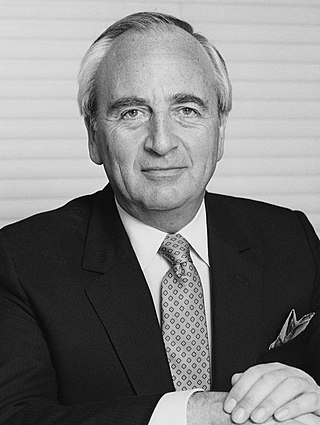
David Ivor Young, Baron Young of Graffham, was a British Conservative politician, cabinet minister and businessman.
Scandlines is a ferry company that operates the Rødby–Puttgarden and Gedser–Rostock ferry routes between Denmark and Germany.

Großenbrode is a municipality in the district of Ostholstein, in Schleswig-Holstein, Germany. It is situated on the Baltic Sea coast, opposite Fehmarn, approx. 8 km (5 mi) east of Heiligenhafen. Until 1963 it had a ferry connection to Gedser in Denmark. After World War II there was no ferry connection from West Germany to Denmark - the ferry port Warnemünde now being in the communist east. Großenbrode was chosen as the site for a temporary ferry connection for the 3 hour crossing to Gedser. After the Fehmarnsund bridge was built in 1963, the ferryport moved to Puttgarden on Fehmarn. Großenbrode is planned to be the site of a portal of the Fehmarn Sound Tunnel by 2028.
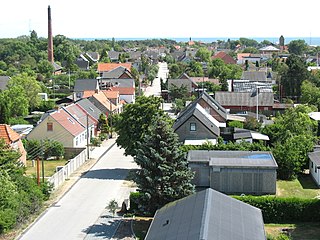
Gedser is a town at the southern tip of the Danish island of Falster in the Guldborgsund Municipality in Sjælland region. It is the southernmost town in Denmark, and also the southernmost point of Scandinavia and the Nordic countries. The town has a population of 659. It is an important port town on the Baltic Sea.

The Hanse Sail in Rostock is the largest maritime festival in Mecklenburg (Germany) and one of the largest in Europe.
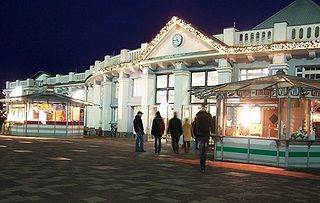
Rostock Hauptbahnhof, also Rostock Central Station, is the main railway station in the German city of Rostock. It is situated well to the south of the city centre, to which it is linked by tram. The station was opened in 1886 by the Deutsch-Nordischer Lloyd, operating a combined railway/ferry line to Nykøbing Falster in Denmark. The station was expanded in 1913 and 1922, but was heavily damaged in World War II. The importance of the traditional route to Hamburg and Copenhagen diminished after the post-World War II division of Germany, with long-distance services instead focusing on cities within the German Democratic Republic. Electrification reached the station in 1985. After German reunification, the station was extensively modernised.

The Gedser-Rostock bridge was a proposed project that would have linked the Danish island Falster with Rostock in Germany. The 45 km (28 mi) route across the Baltic Sea would have been part of European route E55 and the main link between Scandinavia and Berlin. It was rejected in 2007 in favour of the Fehmarn Belt tunnel, which finally began construction in 2021.

The Vogelfluglinie (German) or Fugleflugtslinjen (Danish) is a transport corridor between Copenhagen, Denmark, and Hamburg, Germany.

The Grand Duchy of Mecklenburg Friedrich-Franz Railway was the state railway company in Mecklenburg-Schwerin and Mecklenburg-Strelitz. After its second nationalisation in 1890 up to the merger of the Länderbahnen into the Deutsche Reichsbahn in 1920 it was under the direction of the Grand Duchy's Executive Railway Board in Schwerin.
The Port of Mersin, is a major seaport located on the north-eastern coast of Mediterranean Sea in Mersin, southern Turkey. As one of the largest harbors in the country, it is Turkey's main gateway to the Mediterranean Sea. It was constructed during the 1950s as a major government project. It is the country's second largest port after Ambarli, near Istanbul. Owned by the Turkish State Railways (TCDD), its operating right is transferred on May 11, 2007, to PSA – Akfen consortium for a period of 36 years.

The Neustrelitz–Warnemünde Railway is a railway line in the North German state of Mecklenburg-Vorpommern. Most of the line is a double-tracked, electrified main line and runs for almost 130 kilometres from Neustrelitz to Warnemünde. It is also known in German as the Lloydbahn, referring to the Deutsch-Nordischer Lloyd company, which built the line and operated it in its early years after its opening in 1886.

Warnemünde Lighthouse is a lighthouse situated on the Unterwarnow, the estuary of the Warnow river, in Warnemünde, a district in the city of Rostock. The lighthouse has a height of 36.9 metres (121 ft) and was put into service in 1898.

The Bad Kleinen–Rostock railway is a double track electrified railway in the German state of Mecklenburg-Vorpommern. The Ludwigslust–Bad Kleinen section of the line is double track. The line was opened in 1850 by the Mecklenburg Railway Company and is one of the oldest railways in Germany and is part of the Leipzig–Magdeburg–Schwerin–Rostock main line.

Puttgarden station is a major ferry terminal on the Vogelfluglinie on the island of Fehmarn in the German state of Schleswig-Holstein. It lies between the town of Puttgarden and Marienleuchte.
The region of Middle Mecklenburg represents that area of the German state of Mecklenburg-Vorpommern with the most developed infrastructure in a state that is otherwise rather underdeveloped structurally. Middle Mecklenburg includes the largest urban centre in the state, the Hanseatic city of Rostock with its 200,000 inhabitants together with the surrounding district of the same name. The most important river in the region is the Warnow. Its transport links radiate from Rostock in a star configuration and the metropolitan region of the port city is served by a public transport network that includes the Rostock S-Bahn. Other important centres are the county towns of Bad Doberan and Güstrow. The main tourist attraction is the Baltic Sea coast along the Bay of Mecklenburg with the Salzhaff, the sea cliffs and the seaside resorts of Rerik, Kühlungsborn, Heiligendamm, Warnemünde and Graal-Müritz. In the south Middle Mecklenburg transitions into the naturally very unspoilt region of the Mecklenburg Lake District. In the east the River Recknitz forms its boundary with West Pomerania, in the west it merges gradually into West Mecklenburg.
The Mecklenburg Spa Railway is a non-electrified, single track branch line in the north of the German state of Mecklenburg-Vorpommern. It runs from Rövershagen, east of the Hanseatic city of Rostock, to Graal-Müritz on the Baltic coast. Its name came originally from the name of its operator and was later transferred to the line.
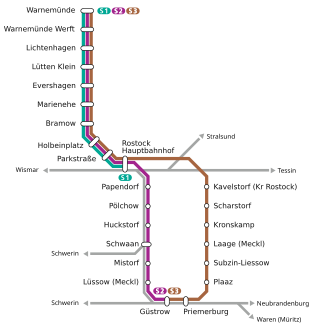
The Rostock S-Bahn is a S-Bahn network in Rostock in the German state of Mecklenburg-Vorpommern. It consists of three lines with a total length of about 90 km. Line S1 runs from Rostock Hauptbahnhof to Warnemünde within the Rostock urban area. S-Bahn operations started on 28 September 1974. Later, the lines to the north-east to the port (Seehafen) of Rostock and to the south to the town of Güstrow via Schwaan were included in the S-Bahn network. The line to the port was discontinued in 2012, but at same time the line to Güstrow via Laage was included as line S3 of the S-Bahn. Until 2014 the rolling stock mainly consisted of push–pull trains with Waggonbau Görlitz double-deck coaches. Since then all lines have been operated with new Bombardier Talent 2 railcars.
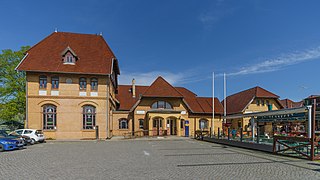
Warnemünde station is located in the seaside resort of Warnemünde, a district of the Hanseatic city of Rostock in the German state of Mecklenburg-Vorpommern. The station opened on 30 September 1903 and is located on the Neustrelitz–Warnemünde railway. It is the terminus of all three Rostock S-Bahn lines. In addition, some long-distance trains serve the station. Until 1995, it was the starting point of ferries to Gedser in Denmark. The station building and some other facilities of the station have heritage protection.

















